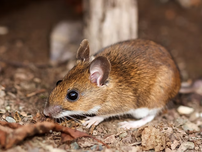top of page
All Posts


Mange in animals is nothing to joke about
“Mangy mutt” may sound playful, but mange is a serious, contagious skin disease caused by direct contact with mites. It leads to hair loss, scabs, and severe discomfort in mammals like dogs, coyotes, and squirrels. Mange weakens animals, making them lethargic, depressed and susceptible to infections. It’s diagnosed via skin scraping examination and can be treated with medication, though severe cases may be fatal. Mites can also affect humans, causing scabies, which is treatab


What's the difference: beaver vs. muskrat
Both beavers and muskrats are semi aquatic rodents that live in lodges with brown fur and long tails making them hard to tell apart in the water. They are not closely related but have evolved to have many shared behaviors and traits. The main differences between them are their size and tail shapes. Beavers are considerably larger and longer than muskrats and have flat, wide tails while a muskrat has a long, skinny tail covered in black hairs. Also, only beavers build dams whi


Whooo's out there? Mourning doves can sound like owls
A mourning dove’s cooing can be heard in the early morning and throughout the day. They are diurnal ground seed eaters with grayish-brown feathers and black spots on their wings. Baby mourning doves rely on their mother’s crop milk, also known as pigeon milk, for a week before becoming about the size of an adult mourning dove and ready to leave the nest two weeks after hatching. Their ability to fly up to 55 mph allows them to escape from predators such as cooper’s hawks and


Why are woodpeckers so noisy? They have a lot to say
You can hear a woodpecker’s tattooing, or tapping, echo throughout the whole forest, especially from late winter through early spring. Woodpeckers will use more than just trees as their stage to make the most noise. The main reasons for tattooing include attracting mates, claiming territory (aggressive drumming), and to communicate with their partners. Woodpeckers peck away at trees for food and can find where insects are hiding based on sound.


A fox in a tree? Gray foxes are good climbers
The gray fox (Urocyon cinereoargenteus) is the only canid in America that climbs trees. They use their front legs to grasp a tree trunk, then use their back legs to push themselves up. Gray foxes are opportunistic foragers and use their sharp senses of sight, smell and sound to find their food. Breeding season for the gray fox is February through March where three to five pups on average are born by mid-May. Pups are ready to mate even before they are 1 year old.


Go owling like a pro
Owling is a fun winter adventure. In Will County, you might spot great horned, barred, barn or eastern screech owls. Dress warmly, stay quiet and be patient. Go out at dusk or night, leave flashlights off, and try your own yard or neighborhood. Don’t play owl calls or get too close—February is nesting season. Watch, listen and enjoy the stars while searching for these amazing birds.


The not-so-golden American goldfinch
Winter is a great time to birdwatch, especially for American goldfinches, which live in Illinois year-round. Males are bright yellow in summer but turn dull in winter. They are the only finch that molts twice a year. Their roller-coaster flight and “po-ta-to-chip” call make them easy to spot. Goldfinches mainly eat seeds, preferring sunflowers, thistles and asters. They nest late in summer to feed their young with seeds.


Don't be scared. Wolf spiders are harmless
Wolf spiders are large and hairy but harmless! They don’t spin webs to catch prey. Instead, they chase it down. They have eight eyes in three rows and fang-like mouthparts called chelicerae. Females carry eggs in silk sacs, and babies ride on their backs after hatching until they can survive on their own. Found worldwide, wolf spiders eat insects and small spiders. Though they may bite if provoked, their bite isn’t dangerous to humans.


The least weasel: Illinois' smallest carnivore
Being one of only two weasel species to live in Illinois, the least weasel measures at only 10 inches in length making them the smallest carnivores in the state. Least weasels are fierce predators that prefer open areas like prairies and farm fields and are mostly nocturnal. The size of their home depends on rodent population where fewer pray equates to larger homes. Their slender bodies are built to hunt in underground tunnels. Weasels must stay active and keep eating.


Deer sport puffy coats to keep them warm in winter
tailed deer stay warm in winter with thick fur and hollow guard hairs that trap warm air, like a natural blanket. They also stay dry with oils that repel moisture. Other animals, like birds, otters and beavers, use similar methods. These adaptations inspire winter gear like puffy coats and new wetsuit designs. To stay safe outside in winter, wear layers and stay dry Just like the animals do!


How do snakes survive winter? By hiding away in a cozy place
Snakes prepare for winter by finding a hibernaculum - a cozy spot that stays above freezing. Being cold-blooded, they can’t generate body heat, so they stop eating and try to find a warm enough spot – often underground below the frost line - to survive the cold. Sometimes, many snakes share one space, creating a "mating ball" in spring. You can build a backyard hibernaculum to support snakes and other wildlife!


White-footed mice are beneficial creatures, not pesky pests
The white-footed mouse (Peromyscus leucopus) is common in Illinois. They can live in many different habitats but avoid grasslands and crops. It has white feet, a white undertail, and varies in fur color. Omnivorous and nocturnal, white-footed mice eat seeds, insects, and fungi. They are prey for many animals and can help spread fungal spores. These mice breed quickly and rarely enter homes. They host deer ticks but also aid Lyme disease research and indicate forest health.


Ground squirrels are squirrels that look like chipmunks
You can easily tell a thirteen-lined ground squirrel apart from a chipmunk by looking at the length and number of stripes they have. Native to the United States, thirteen-lined ground squirrels have 13 stripes on their backs that alternate between dark and light brown and have a tail that is half the length of its body. They are diurnal omnivores and can hibernate for as long as eight months. They spend a lot of time underground and can be found in areas with short grass.


How do beavers hold their breath for so long?
Beavers can hold their breath for up to 15 minutes—much longer than humans. Beavers are naturally adapted for their aquatic lifestyle. They slow their heart rate, redirect blood to vital organs, and have high levels of myoglobin, a protein that supplies oxygen for aquatic mammals to use while under water. This lets them stay submerged longer. Though impressive, elephant seals can hold their breath for much longer, staying underwater for up to two hours.


The science behind a fishing spider's superpower
Fishing spiders do not spin webs and can walk on water thanks to surface tension and hunt using vibrations. They fish for prey like minnows and tadpoles and can also hunt insects on land. Fishing spiders can breathe underwater using air bubbles trapped by special hairs. Though large and venomous, they’re mostly harmless to humans. They use their powers to survive, not for fun!


Make a cute turtle companion out of yarn and popsicle sticks
Make a yarn turtle craft using three green-colored Popsicle sticks tied together in a snowflake shape. Wrap yarn around the center to form a mound, then continue winding yarn around each stick in a circle. Use 2 to 4 yarn colors for variety.


Fox snakes may act tough, but they are harmless
A caller to Plum Creek Nature Center mistook a western fox snake for a rattlesnake after it hissed and rattled its tail, putting on a defensive show. These nonvenomous snakes live in grasslands, prairies and farm fields, where they help control rodent populations. They mimic rattlesnakes by shaking their tails in dry vegetation and may also hiss or release a musky smell. Instead of harming it, the caller released the snake - great news for their farm!


The bold jumping spider looks and acts the part
Named for their fearlessness and bravery, bold jumping spiders, Phidippus audax, are the most common jumping spiders in North America and can be found in forests, prairies, farmland, yards, and in homes. Their venom is not dangerous but can irritate the skin. Rather than spinning webs, these stealthy daytime hunters rely on their sharp vision to stalk prey and drop draglines (strands of silk) to secure themselves onto a surface. Juveniles can take up to six molts before becom


Why do snakes shed their skin?
Snakes are unique in shedding their skin all at once in a process called ecdysis. They do this because their skin doesn’t grow with them, so it becomes too tight or worn out. Shedding also helps remove parasites. Younger snakes shed more often while adults shed a few times a year. Before shedding, their skin may appear dull and their eyes cloudy. They start the process by rubbing against rough surfaces. The shed skin can reveal scale patterns and even the snake’s species.


Common and cute: Learn more about cottontail rabbits
Native to North America, the eastern cottontail rabbit is the most common cottontail and the only wild rabbit that lives in Will County. They are herbivores and crepuscular, and can be found in open, grassy areas. Baby cottontail rabbits are called kittens and will reach their full adult size 6 months after birth. Their fur coat changes color throughout the year, shedding its light-brown summer fur to a thick, gray winter coat. Cottontail rabbits help regulate populations and
bottom of page